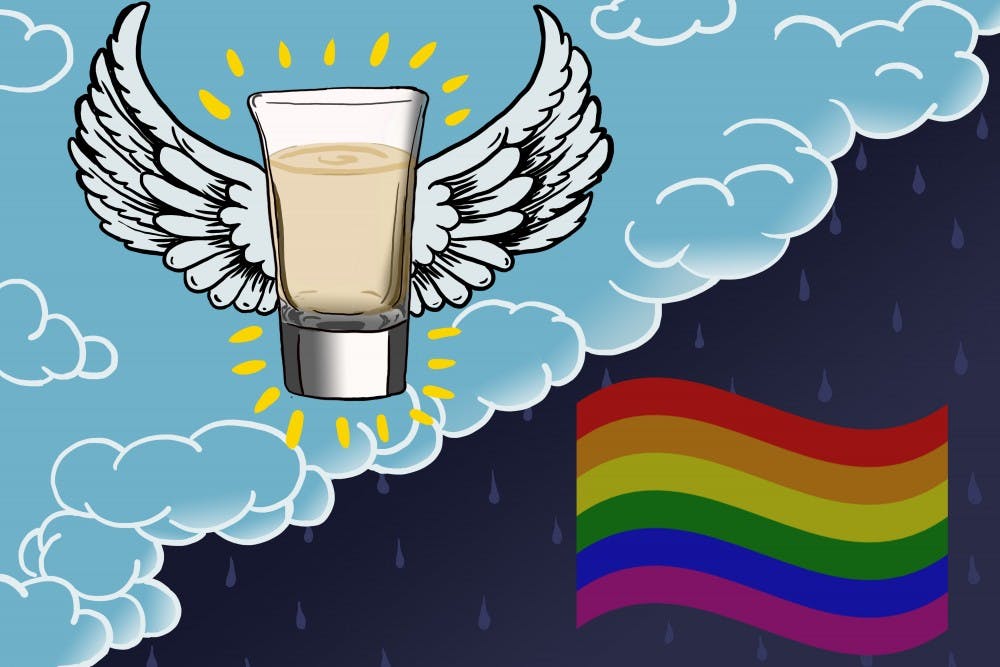Angel shots provide safety for women when a date goes wrong. Within the LGBT community, however, the basic concept is impossible, forcing a discussion about dating risk not only within the LGBT community but for all students.
The angel shot concept went viral over the past month for its promised ability to allow people on dates gone wrong to discretely request assistance from a bartender using a code based on a fake drink. With three different levels of request, ranging from being walked to one’s car to calling the police, women who feel under the threat of violence can find a way to escape a negative situation.
The mechanism for the angel shot, however, is signs posted in the bathroom of one gender that give the name of the shot (which by necessity changes from one establishment to the next to be more discreet). This mechanism inherently excludes the LGBT community.
While women on heterosexual dates are perceived as the largest group at risk of dating violence, the angel shot fundamentally leaves out that they are not the only people at risk of violence while dating and provokes a simple question: Can the LGBT community benefit from heteronormative violence-reduction strategies?
The angel shot makes it clear that, at least in this case, the answer is no.
Angel shots presume that one partner in an opposite sex pairing is significantly more at risk than the other, which is true particularly by raw numbers in the early stages of opposite-sex dating. Nonetheless, this means that same-sex couples are unable to take advantage of this, as the angel shot concept requires one partner to not have access to the name of the drink.
The LGBT community cannot conceivably benefit from such a scheme without dividing partners into fixed sexual roles, which ignores reality, and then dividing them into separate spaces, which again ignores reality.
The angel shot protects women dating members of the opposite sex from some violence and is a welcome addition to the arsenal of methods to protect all people looking to date. As one part of this arsenal, it’s important to remember what other options were available before the angel shot went viral.
Roger Dorantes is a bartender at Charlie’s Phoenix, a popular gay club at Camelback and 7th Avenue in Phoenix. While he had not heard of the angel shot, he does say that Charlie’s trains their bartenders to recognize signs of trouble on dates, particularly in patrons’ interactions with the staff.
"We make a safe place by really interacting with the customers,” Dorantes said. "We want to make sure they get some confidence that they can tell us what's going on. We also learn to identify situations in which things look wrong. We notice weird comments or body language toward us or the other person, and we use that to know when they look uncomfortable."
All of this suggests that the need to order an angel shot is something that bartenders should already be trained to recognize, but what it also means is that all of these situations require interaction with bar staff.
When it comes to dance floors and other crowded parts of bars, that’s simply not feasible.
In this case, bystander intervention is necessary or the couple is essentially alone, meaning that whether the angel shot is available or not wouldn’t matter.
For example, this weekend there was no bartender in sight when I had to wrestle an arm that was too drunk to understand a simple no out of my jeans. An LGBT-friendly angel shot wouldn’t have changed that situation.
Unwanted sexual attention including various forms of assault is a possibility during any interaction, and the angel shot is an attempt to reduce risk. Nonetheless, even as it goes viral, it doesn’t represent a panacea.
Bar staffs are working to ensure that they keep patrons safe, but staff will only be able to go so far with any tool gone viral. Recognizing the limits of angel shots to keep patrons safe is necessary to provoke further conversations about the need to focus on the safety of all patrons, LGBT or straight.
Reach the columnist at benjamin.steele@asu.edu or follow @blsteele17 on Twitter.
Editor’s note: The opinions presented in this column are the author’s and do not imply any endorsement from The State Press or its editors.
Want to join the conversation? Send an email to opiniondesk.statepress@gmail.com. Keep letters under 300 words and be sure to include your university affiliation. Anonymity will not be granted.
Like The State Press on Facebook and follow @statepress on Twitter.




